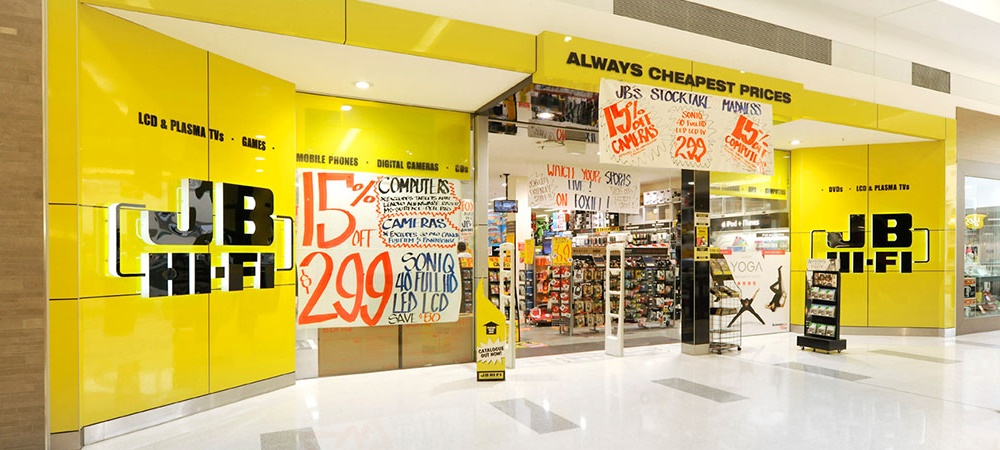Australia can now claim three of the world’s biggest retailers with JB Hi-Fi joining Wesfarmers and Woolworths in Deloitte’s retailing top 250.
Following JB Hi-Fi’s acquisition of The Good Guys in November 2016 and a consistent year-on-year comparative sales growth, the retailer entered the list at 218.
Wesfarmers and Woolworths maintained their spots in the top 25, coming in at 21 and 23 respectively, compared to 21 and 24 in 2017.
Prepare for more competition
Only 15 per cent (38) of the top 250 global retailers currently operate in Australia, but David White, national leader of Deloitte’s retail, wholesale and distribution group, said he expects further competition to come from international retailers.
“With so much change and uncertainty in the Australian retail landscape, 2018 could be a pivotal year for many Australian retailers,” he said.
“Ongoing population growth, a strong tourism market and improving wages are all set to ensure the overall retail market continues to grow in 2018. However, with the increase in competition from both international and domestic retailers, we can expect to see further consolidation in the sector.”
Competition will also come from international players outside the top 250, like UK sports-fashion retailer JD Sports, which now has five stores in Australia.
“Also, well-established international players in the luxury retail market, such as Swarovski and Tiffany & Co, have opened new stores, expanded existing footprints and introduced new brands to our market,” said White.
“We also saw the French-owned retailer Décathlon open its first bricks-and-mortar store in Australia in 2017 and Amazon’s long-anticipated arrival to our shores.”
Potential disruptors to the Australian retail landscape
White identified three areas that have the potential to disrupt the Australian retail landscape in the long-term.
1. Amazon. The online giant’s launch might not have been the big bang many were predicting, but White said retailers underestimate Amazon at their peril.
“As Amazon builds out its infrastructure and services in Australia in 2018, we can expect its presence and influence on the market to grow significantly, particularly in the second half of the year and in the lead up to Christmas.
“We’ll have to wait and see the ultimate impact of Amazon’s on-shore business in Australia, but it’s important to remember this also creates opportunities for Australian retailers.”
2. Lidl. Discount supermarket Lidl is owned by the fourth largest retailer in the world, The Schwarz Group, and has created a lot of buzz recently with local land purchases, securing of trade markets, and talent acquisition. Lidl’s potential entry into the Australian market could have a big impact on the grocery sector.
“Should Lidl choose to set up shop in Australia, it will take time for the full effect to be felt, in much the same way Aldi took a number of years to grow its market share here,” said White. “The impact of Lidl in markets such as the UK has been transformational for the sector. It’s certainly another case of wait and see.”
3. China. A number of Chinese retailers and online marketplaces are either entering the Australian market or expanding their operations here. Alibaba opened its Australian headquarters in Melbourne in 2017, JD.com is expected to follow suit shortly, and Vipshop Holdings (VIP.com) opened a distribution centre in Sydney.
White said these fast-growing Chinese companies are starting to make a significant impact on the global retail market, which could be extremely beneficial for Australian retailers. “This provides Australian retailers with a huge opportunity to take advantage of high Chinese demand for Australian products.”
‘Transformative time in retail’
Technology has empowered shoppers, placing them firmly in the driver’s seat, said White. This means retailers need to adapt to their customers’ needs.
“Across the retail industry, disruption of traditional business models has given way to unprecedented and transformative change—change required online and offline to better serve more demanding shoppers and redefining customer experience.”
Building top-notch digital capabilities—From the consumer perspective, shopping is not about bricks versus clicks or one channel versus another. Retailers are rapidly adapting to the fact that consumers are channel-agnostic.
Combining bricks-and-clicks makes up for lost time—Retailers who initially failed to keep up with digital trends are now making up for lost time by combining bricks and clicks.
Creating unique and compelling in-store experiences—Physical retail stores are not going away; according to Deloitte 90 per cent of worldwide retail sales are still done in physical stores. However, to compete with the convenience and endless aisle assortment offered online, bricks-and-mortar retailers are focusing on meaningful customer experiences and brand engagement.
Reinventing retail with technology—The Internet of Things, artificial intelligence, robots, and augmented and virtual reality should be on every retailer’s radar.
Top 10 global retailers by revenue
| Top 250 ranking FY16 | Company | Country of origin | FY16 retail revenue (US$m) | Top 250 ranking FY15 |
| 1 | Wal-Mart Stores, Inc. | US | 485,873 | 1 |
| 2 | Costco Wholesale Corporation | US | 118,719 | 2 |
| 3 | The Kroger Co. | US | 115,337 | 3 |
| 4 | Schwarz Group | Germany | 99,256 | 4 |
| 5 | Walgreens Boots Alliance, Inc. | US | 97,058 | 5 |
| 6 | Amazon.com, Inc. | US | 94,665 | 10 |
| 7 | The Home Depot, Inc. | US | 94,595 | 6 |
| 8 | Aldi Group | Germany | 84,923e | 8 |
| 9 | Carrefour S.A. | France | 84,131 | 7 |
| 10 | CVS Health Corporation | US | 81,100 | 12 |

